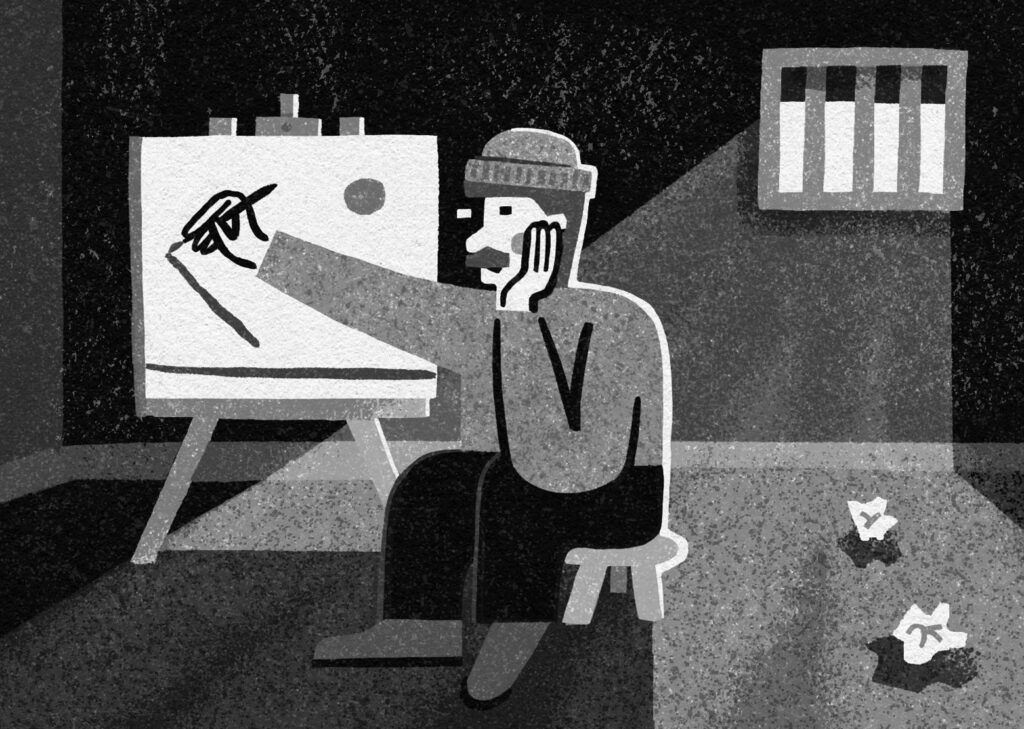Absurd, animated, and abundant in mischief, The Abduction of Seven Forgers is the latest work from the novelist and playwright Sean Dixon, whose 2014 drama, A God in Need of Help, was nominated for a Governor General’s Award. With characteristic wit and whimsy, Dixon offers an intricate meta-narrative: the novel presents as the manuscript of a memoir penned by the protagonist, complete with sketches, strike-throughs, redactions, and morphing typography. He successfully balances hilarity with poignancy in an unorthodox package.
The young artist Olive believes herself “ugly” because of “physical challenges,” including a hunchback, a deviated septum, and an unidentifiable skin condition that “looks sort of like a combination of eczema and a strange loss of pigment around my eyes that leaves me looking racoonish.” Accordingly, she chases “the beauty of the world” with morbid desperation, pouring into her work the elegance that she cannot see in herself: “I thought myself repugnant, both to look at and to listen to.” Naturally, when the Torontonian receives a Facebook message from a “resplendent” art dealer inviting her to be “feted” at an alluring home in London, England, she accepts with enthusiasm, bringing only a knapsack and her meagre self-confidence.
When she arrives at her rendezvous, she is not greeted with fanfare. Instead, Olive meets several other guests who are as surprised to see her as she is to see them. There’s the miniaturist Amir Haghighi and his “milk sister,” Sanam, a prodigious Sunni calligrapher with whom he once shared a wet nurse. As much as the pair quarrel, their relationship is healthier than that of the artists Armando Matamoros and Ángela Efrena Quintero, whose engagement fell apart spectacularly three years earlier. Keeping away from the drama are the eccentric magician Jan Komárek, who calls himself “an alchemist,” and the lone‑wolf performance artist Hannie Van der Roos, who seems comfortable only in the company of the attractive woman behind the invitations, Ella Unton Bride, who won’t reveal why the group has been gathered.
The plot explodes into action, literally, as a blast destroys the living room window. The bewildered party meet their host, unscathed, unbothered, and impeccably dressed among the shattered glass: Mr. Jackie Lin. The “bitter but fun-loving South Korean art collector” accuses each guest of selling him counterfeit compositions: “You all share the common distinction of having defrauded me with your talent, allowing me to believe that several works of art I have purchased over the years were by someone other than you.” Rather than admit his foolishness by reporting the fraud to authorities, Lin has abducted all seven artists and promises them liberty only once each has covered the walls of their assigned “studios and sleeping quarters” with fresh, authentic works. And he informs them that escape is impossible. Scaffolding encases the house. Satellite signals are blocked. Armed wardens patrol the property. For the seven forgers, art is the sole path to freedom.

Feeling artistically trapped or free to create depends on one’s perspective.
Sandi Falconer
Between catered meals, free rent, and a seemingly infinite budget for supplies, their captivity might seem less like imprisonment and more like every artist’s fantasy vacation. Still, even the most decadent of cages remains a cage. Olive faces her imprisonment with unwavering optimism. “Time went by in there,” she tells us. “I started to like my room.” It is certainly a healthier coping mechanism than Jan’s passive compliance or Hannie’s aggressive protests. (“I have had quite enough of this charade,” the performer proclaims before a botched attempt to run off.) Tensions grow as the disparate characters must learn to trust one another and, if they dare, try to escape.
Just as the seven grow accustomed to their environment, they discover the “allegedly absent” eighth forger, Ezra Coen. The twelve-year-old painter had been invited to the house but was in the bathroom during Lin’s arrival, and he slipped away amid the ensuing commotion. Now he’s hiding in the attic, one false move away from his abductor’s notice and, worse, his wrath. With haste, Olive invites the help of Jan, and the two face their greatest challenge yet. They must convince their fellow artists to work together to conceal the child’s whereabouts — or else risk the boy’s life by exposing him.
Despite Dixon’s playful prose, the novel offers more than light-hearted shenanigans. It explores the overlap between the art and the artist, the conscious and the unconscious, the direct experience and the metaphysical truth. As her captivity stretches from days into months, Olive’s perception of reality unravels. She starts seeing things, including “sometimes figurative, sometimes non-figurative animation running along the walls.” Her emotional barricades come down, too, and she grows especially close with Hannie. Even the robotic facade of Lin fades as the forgers covertly mend his relationship with his estranged daughter, who’s an aspiring creative. It’s perhaps no surprise that a man replete with money and power still misses, above all else, love.
By challenging popular notions of artistic authenticity with earnest novelty, The Abduction of Seven Forgers respects readers’ intellect without sacrificing emotional catharsis. And it serves as a profound suggestion that the freedom found through works of art can transcend the metaphorical. Ultimately, the novel reminds us that good art is a pleasure to see, but great art inspires new ways of seeing.
Jessie Yang studies English literature at Western University.

